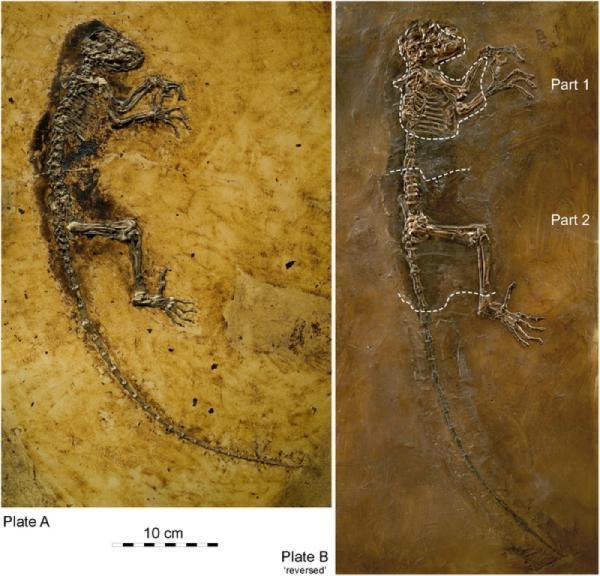Ida fossils were exaggerated
Author: Robert Roy Britt - editorial director
Scientists seem to regularly mold themselves, and sometimes push themselves to obscurity. Those times also make a little noise. The great discoveries rewriting the history of the world deserve a great headline as well as the media's interest and supportive patrons.
Ida fossil discoveries announced this week as if the 47-million-year-old female fossil is like a rock star, and as if it were the first fossil to be applauded.
Today our knowledge is much broader. According to Clara Moskowitz's writings on LiveScience, people were skeptical about whether Joan Jett was indeed the descendant of Ida. The problem is that most of the news has been published, the public will only retain the impression of Ida as a missing link in human evolution.
Although it has been confirmed through conferences and newspapers, no textbook will be edited quickly.
Chris Beard - in charge of vertebrate paleontology at Carnegie Museum of Natural History in Pittsburgh - said: 'It is not a missing link, it is not even a relative. the proximity of monkeys, gibbons and humans while that is the key point they try to assert. '
And these are his mistakes:
Many scientific journalists across the planet are trying to do either, or both:
- confusing to take advantage of this discovery
- struggling with your own questions about the concern that something isn't quite right

Ida is a rock star?(Photo: ScienceDaily)
Maybe New York mayor Michael Bloomberg appeared at the announcement about Ida. It is possible that TV materials revolve around this discovery. Or maybe books are starting to write about it. An exclusive network that covers the activities of both television and network yesterday. It is an overstatement, and you can wonder what they are hiding behind.
The failure began to emerge as the discovery, which was covered in secrecy as a mass media was being leaked, lost and reached The Wall Street and then London's Daily Mail. Next to The New York Times also wrote about the mass media circus born from there. All of this is published before anyone except the research team (and their tightly controlled communication group) knows about the specifics of the discovery.
A quote summarizing what is happening:
Jorn H. Hurum - the lead researcher in the project, told The Times: 'Any pop band will do the same. Any athlete has the same action. We also started to think like that in science. '
It was at this point that the larger holes in the journalists' abdomen grew bigger.
LiveScience certainly appreciates the popularity of science. We also appreciate that. We love science and think science is really great. We know you feel the same way, none of us need a communication machine to weave elements that stun and distort the truth.
The anthropologist Matt Cartmill of Duke University told Moskowitz: 'This fossil PR campaign, I think, is more than a fossil. It is a very beautiful fossil, but I don't see any point in telling me that this is a new fossil '.
Whether Ida is a human ancestor or not, the discovery is of great significance and will be the focus of the press. But to apply PR methods to pop groups and athletes in the announcement about learning too much is a steep slope that can lose the meaning of the whole process.
The event announced Ida was arranged the script. More importantly, now the findings may have been overstated. We do not know for sure until additional studies are conducted. But even if the event caused the public to lose faith in science and media, the stolen faith was in place.
- Exaggerated photos won in 2008 (Part 2)
- Use crumpled roots in traditional medicine
- Exaggerated photos won in 2008 (Part 1)
- Disaster sweeps 90% of dinosaurs are not serious?
- Discover the oldest animal fossils
- The oldest fossils of mankind
- Very rare fossils of gibbons
- Understanding the formation of fossils in nature (1)
- Close up of fossils of crocodiles, elephants, giant prehistoric birds
- Australia found fossils tens of millions of years old
- Explore Antarctica, discover 1 ton of dinosaur fossils
- Understanding the formation of fossils in nature (2)
 Discovered an ancient centipede fossil 99 million years old
Discovered an ancient centipede fossil 99 million years old Discovered bat-like dinosaurs in China
Discovered bat-like dinosaurs in China Discovered a 200-year-old bronze cannon of the coast
Discovered a 200-year-old bronze cannon of the coast Discover 305 million-year-old spider fossils
Discover 305 million-year-old spider fossils Australia successfully decoded fossils that lived about 247 million years ago
Australia successfully decoded fossils that lived about 247 million years ago  280 million year old 'alien' fossil discovered in Western Australia
280 million year old 'alien' fossil discovered in Western Australia  Why are dinosaur fossils more abundant than human bones?
Why are dinosaur fossils more abundant than human bones?  155 million year old sea star fossilized right at the moment of rebirth
155 million year old sea star fossilized right at the moment of rebirth  Discovery of dinosaur fossils with feathers and scales
Discovery of dinosaur fossils with feathers and scales  China discovered sponge fossils dating back about 540 million years
China discovered sponge fossils dating back about 540 million years 